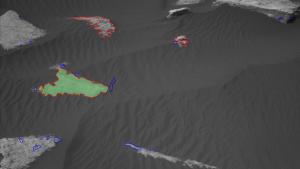Laser-targeting A.I. Yields More Mars Science
A.I. software on NASA's Curiosity Mars rover has helped it zap dozens of laser targets on the Red Planet this past year, becoming a frequent science tool when the ground team was out of contact with the spacecraft. This same software has proven useful enough that it's already scheduled for NASA's upcoming mission, Mars 2020.

This is how AEGIS sees the Martian surface. All targets found by the A.I. program are outlined: blue targets are rejected, while red are retained. The top-ranked target is shaded green; if there's a second-ranked target, it's shaded orange. These NavCam images have been contrast-balanced.
A new paper in Science: Robotics looks at how the software has performed since rolling out to Curiosity's science team in May 2016. The AEGIS software, or Autonomous Exploration for Gathering Increased Science, has been used to direct Curiosity's ChemCam instrument 54 times since then. It's used on almost every drive when the power resources are available for it, according to the paper's authors.
The vast majority of those uses involved selecting targets to zap with ChemCam's laser, which vaporizes small amounts of rock or soil and studies the gas that burns off. Spectrographic analysis of this gas can reveal the elements that make up each laser target.
AEGIS allows the rover to get more science done while Curiosity's human controllers are out of contact. Each day, they program a list of commands for it to execute based on the previous day's images and data. If those commands include a drive, the rover may reach new surroundings several hours before it is able to receive new instructions. AEGIS allows it to autonomously zap rocks that scientists may want to investigate later.
"Time is precious on Mars," said lead author Raymond Francis of NASA's Jet Propulsion Laboratory in Pasadena, California. Francis is the lead system engineer for AEGIS' deployment on the Curiosity rover. "AEGIS allows us to make use of time that otherwise wasn't available because we were waiting for someone on Earth to make a decision."
AEGIS has helped the science team discover a number of interesting minerals. On separate occasions, higher quantities of chlorine and silica were discovered in nearby rocks -- information that helped direct science planning the following day.
"The goal is to provide more information for the science team," said Tara Estlin of JPL, co-author and team lead for AEGIS. "AEGIS has increased the total data coming from ChemCam by operating during times when the rover would otherwise just be waiting for a command."
Before AEGIS was implemented, this downtime was so valuable that the rover was instructed to carry out "blind" targeting of ChemCam. As it was carrying out commands, it would also fire the laser, just to see if it would gather interesting data. But the targeting was limited to a pre-programmed angle, since there was no onboard ability to search for a target.
"Half the time it would just hit soil -- which was also useful, but rock measurements are much more interesting to our scientists," Francis said.
With the intelligent targeting AEGIS affords, Curiosity can be given parameters for very specific kinds of rocks, defined by color, shape and size. The software uses computer vision to search out edges in the landscape; if it detects enough edges, there's a good chance it has found a distinct object, Francis said.
Then the software can rank, filter and prioritize those objects based on the characteristics the science team is looking for.
AEGIS can also be used for fine-scale pointing -- what Francis calls "pointing insurance." When Curiosity's operators aren't quite confident they'll hit a very narrow vein in a rock on the first try, they sometimes use this ability to fine-tune the pointing, though it only came up twice in the past year.
Source: Jet Propulsion Laboratory
- 452 reads
Human Rights
Fostering a More Humane World: The 28th Eurasian Economic Summi

Conscience, Hope, and Action: Keys to Global Peace and Sustainability

Ringing FOWPAL’s Peace Bell for the World:Nobel Peace Prize Laureates’ Visions and Actions

Protecting the World’s Cultural Diversity for a Sustainable Future

Puppet Show I International Friendship Day 2020

